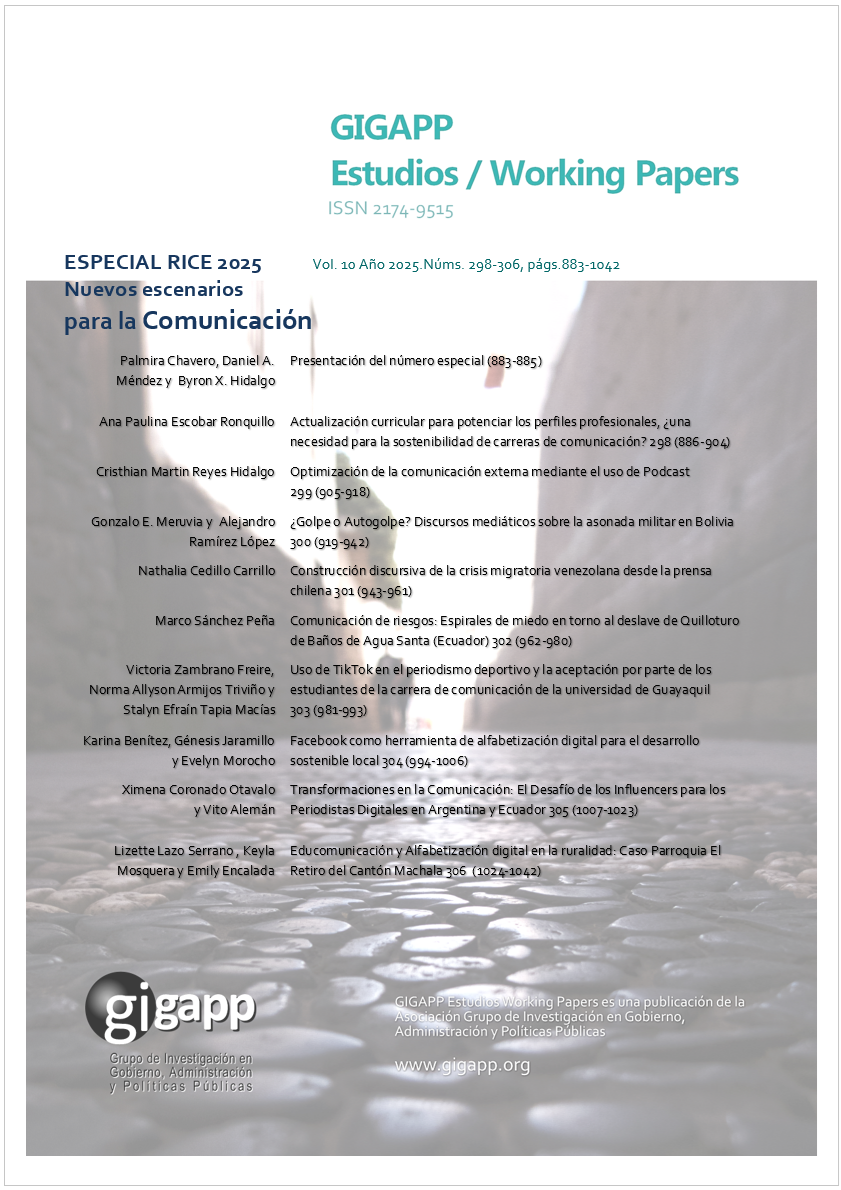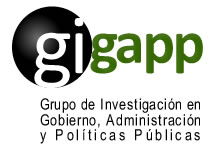Comunicación de riesgos: Espirales de miedo en torno al deslave de Quilloturo de Baños de Agua Santa (Ecuador)
Resumen
La comunicación de riesgos ha experimentado variaciones en su forma y protocolos de diseño y emisión encargando su función en actores que emergen de las plataformas digitales. La información y la inmediatez ya no pertenecen a quienes tienen la misión de manejarla responsablemente, apareciendo en el ecosistema de medios sociales fenómenos de comunicación colectiva impulsados por el diálogo social y el contagio emocional. El presente estudio identifica el aparecimiento de espirales de miedo en torno a las publicaciones digitales sobre el deslave en la comunidad de Quilloturo, parroquia Río Verde del cantón Baños de Agua Santa en Ecuador. Utilizando una herramienta de escucha social se monitoreó las conversaciones que circularon sobre el suceso del fenómeno natural, determinando insights, términos de referencia y sentimientos que emergen de las publicaciones. El riesgo es percibido por los términos base y datos utilizados en las publicaciones, también los componentes de las espirales de miedo aparecen en los sentimientos emitidos en las publicaciones digitales. Es posible que los periodistas se estén convirtiendo en especialistas de la rutinización de la imprevisibilidad con el aporte de actores sociales en la web que emiten contenido. Dicha acción implica que los discursos informativos están configurando emociones en lo digital que pueden generar afectaciones psicoemocionales.
Descargas
Citas
Bauman, S. (2000). Modernidad líquida (Primera). Fondo de Cultura Económica.
Canaza-Choque, F. (2018). La sociedad 2.0 y el espejismo de las redes sociales en la modernidad líquida. In Crescendo, 9(2), 221-247. https://www.aacademica.org/franklin.americo.canazachoque/6
Caro Castaño, L. (2015). Relaciones e interacciones parasociales en redes sociales digitales. Una revisión conceptual. Revista ICONO14 Revista científica de Comunicación y Tecnologías emergentes, 13(2), 23-47. https://doi.org/10.7195/ri14.v13i2.853
Covello, V., & Sandman, P. (2001). Risk communication: Evolution and Revolution. http://www.psandman.com/articles/covello.htm
Delumeau, J. (2002). El miedo. Reflexiones sobre su dimensión social y cultural (Primera). Corpora-ción Región. https://biblioteca.clacso.edu.ar/Colombia/corporacion-region/20180109043802/reflexiones.pdf
Denisova, A. (2023). Viral journalism. Strategy, tactics and limitations of the fast spread of content on social media: Case study of the United Kingdom quality publications. 24(9), 1919-1937.
Ehsen, Z. R., & Alam, K. (2022). COVID-19: An age of fear, simulacra, or reality? Contemporary So-cial Science, 17(2), 143-156. https://doi.org/10.1080/21582041.2021.1942964
Eiroa, M., & Barranquero, A. (2017). Métodos de investigación en la comunicación y sus medios (Primera). Síntesis.
El Telégrafo. (2024, enero 21). El Telégrafo—Alerta por plomo en lote de salsa de tomate. https://www.eltelegrafo.com.ec/noticias/nacionales/44/alerta-por-plomo-en-lote-da-salsa-de-tomate
Elías Pérez, C. (2015). El selfie de Galileo. Software social, político e intelectual del siglo XXI (Prime-ra). Ediciones Península.
Farré Coma, J. (2005). Comunicación de riesgo y espirales del miedo. Comunicación y sociedad, 3, 95-119. http://www.scielo.org.mx/scielo.php?script=sci_abstract&pid=S0188-252X2005000100095&lng=es&nrm=iso&tlng=es
Fernández, M. (2008). Una zanahoria para todos los conejos. El nacimiento de la primicia: Sobre el estatus social de una obseción periódistica. Question, 1(18). https://perio.unlp.edu.ar/ojs/index.php/question/article/view/52
Ferrara, E., & Yang, Z. (2015). Measuring Emotional Contagion in Social Media. PLOS ONE, 10(11), e0142390. https://doi.org/10.1371/journal.pone.0142390
Gutiérrez, E. C. (2013). Wikiperiodismo O Periodismo Colaborativo: ¿Tiene Futuro? Revista de Co-municación de la SEECI, 32, 12-30. https://www.proquest.com/docview/1509070775/abstract/97485DD5E3F049FAPQ/1
Karlsson, J., & Larsson, M. (2016). Adapting infinite-scroll with the user experience in mind. https://urn.kb.se/resolve?urn=urn:nbn:se:liu:diva-131462
Liotti, J. (2011). Cobertura periodística y redacción. Universidad Católica de Argentina. https://abelsuing.files.wordpress.com/2011/09/guia-diacc81ctica-liotti.pdf
Lorenzo, E. Y., & Romo, A. R. (2020). La evolución de los insights desde la escucha social a la lectura por imagen: El caso L’Oreal. aDResearch ESIC International Journal of Communication Re-search, 23(23), Article 23. https://doi.org/10.7263/adresic-023-01
Martín-Barbero, J. (2010). De los medios a las mediaciones: Comunicación, cultura y hegemonía (Primera Edición). Rubí.
Noelle-Neumann, E. (1995). La espiral del silencio. Opinión pública: Nuestra piel social (Tercera). Paidós.
Oficina de Naciones Unidas para la Reducción del Riesgo de Desastres. (2021). Funciones y respon-sabilidades de los medios de comunicación. Naciones Unidas. https://goo.su/lXZRJHz
Pasquel-López, C., & Valerio-Ureña, G. (2022). Contagio emocional en las redes sociales: El caso de COVID-19 en Facebook. Texto Livre, 14, e29080. https://doi.org/10.35699/1983-3652.2021.29080
Pérez-Soler, S. (2017). Periodismo y redes sociales (Primera). UOC. https://www.editorialuoc.com/periodismo-y-redes-sociales
Potter, D., & Ricchiardi, S. (2006). Cobertura de desastres y crisis. International Center for Journal-ists, Washington. http://www.centroperiodismodigital.org/sitio/sites/default/files/ICFJ_disaster_ESP.pdf
Rico, M. (2012). Periodista multimedia interactivo: Eje de los grupos de comunicación españoles. Cuadernos.info, 31, 103-116. https://doi.org/10.7764/cdi.31.457
Servimedia. (2016). Los Medios y su público: ¿las redes sociales propician el diálogo? Estudio de Comunicación. https://www.estudiodecomunicacion.com/servicios/los-medios-y-su-publico-las-redes-sociales-propician-el-dialogo/
Talaga, S., & Nowak, A. (2020). Homophily as a Process Generating Social Networks: Insights from Social Distance Attachment Model (No. arXiv:1907.07055). arXiv. https://doi.org/10.48550/arXiv.1907.07055
Torreblanca, F. (2021, noviembre 17). Insights sobre sentimientos del consumidor actual: Miedo. Blog de Francisco Torreblanca. https://franciscotorreblanca.es/insights-sentimientos-consumidor-actual-miedo/
Toulkeridis, T. (2015). Prevención de riesgo en el Ecuador. Universidad de las Fuerzas Armadas-ESPE.
Ulloa, F. (2011). Manual de Gestión del Riesgo de desastre para comunicadores sociales. UNESCO..
Derechos de autor 2025 Marco Sánchez Peña (Autor/a)

Esta obra está bajo licencia internacional Creative Commons Reconocimiento-NoComercial-CompartirIgual 4.0.
Aquellos autores/as que tengan publicaciones con esta revista, aceptan los términos siguientes:
a. Los autores/as conservarán sus derechos de autor y garantizarán a la revista el derecho de primera publicación de su obra, el cuál estará simultáneamente sujeto a la Licencia de reconocimiento de Creative Commons Attribution-NonCommercial-ShareAlike 4.0 International (CC BY-NC-SA 4.0) que permite a terceros compartir la obra siempre que se indique su autor y su primera publicación esta revista.
Con esta licencia de acceso abierto, los lectores (usuarios) pueden:
- Compartir — copiar y redistribuir el material en cualquier medio o formato
- Adaptar — remezclar, transformar y construir a partir del material
Bajo los siguientes términos:
-
Atribución — usarios deberán dar crédito de manera adecuada, brindar un enlace a la licencia, e indicar si se han realizado cambios. Puede hacerlo en cualquier forma razonable, pero no de forma tal que sugiera que usted o su uso tienen el apoyo de la licenciante.
-
NoComercial — usuarios no puede hacer uso del material con propósitos comerciales.
-
CompartirIgual — Si remezcla, transforma o crea a partir del material, usuarios deben distribuir su contribución bajo la misma licencia del original.
-
Sin restricciones adicionales: los usuarios no pueden aplicar términos legales o medidas tecnológicas que restrinjan legalmente a otros de hacer cualquier cosa que permita la licencia.
b. Los autores/as podrán adoptar otros acuerdos de licencia no exclusiva de distribución de la versión de la obra publicada (p. ej.: depositarla en un archivo telemático institucional o publicarla en un volumen monográfico) siempre que se indique la publicación inicial en esta revista
c. Se permite y recomienda a los autores/as difundir su obra a través de Internet (p. ej.: en archivos telemáticos institucionales o en su página web) antes y durante el proceso de envío, lo cual puede producir intercambios interesantes y aumentar las citas de la obra publicada. (Véase El efecto del acceso abierto).



